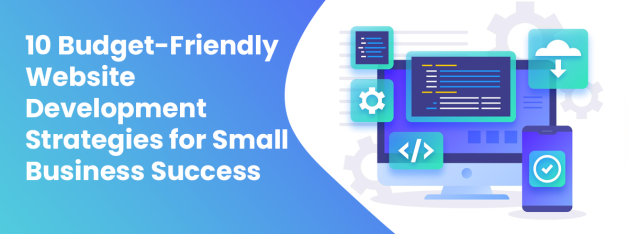10 Budget-Friendly Website Development Strategies for Small Business Success

For small business owners, having a strong small business website isn’t just an option—it’s a necessity. But building a website from scratch can feel overwhelming, especially when working with a tight budget.
The good news is that it does not require much to invest in a professional high-performing site. Smart strategies and cost-effective tools help develop a designed website, which attracts potential customers and ranks well on search engines. The visitors become faithful buyers for the business. Here are 10 budget-friendly website development strategies to help your business succeed online.
1. Choose an affordable web host
Your web host is the foundation of your website—it determines speed, security, and uptime. For small business owners, a budget-friendly but reliable hosting provider is essential.
What to Look for in a Web Host:
- Affordable plans starting at $5–$10 per month
- Good customer support
- Free SSL certificate for security
- Fast loading times
Examples of Budget-Friendly Hosting Providers:
- Bluehost – Great for WordPress websites
- SiteGround – Reliable and user-friendly
- Hostinger – Extremely affordable
Pro Tip: Most hosting providers offer discounted rates for the first year, so look for promotional deals before signing up.
2. Use Website Builders for Easy and Affordable Development
Hiring a professional web developer can cost thousands of dollars, but small business owners can build their own websites using website builders with drag-and-drop functionality.
Best Budget-Friendly Website Builders:
- Wix – User-friendly, great templates, free plan available
- Squarespace – Sleek, inexpensive monthly plans
- WordPress– Is very flexible and SEO friendly, and works great for content-heavy websites.
Example: Using Wix’s free plan, a local florist created a simple website. Six months after sales picked up, they upgraded to a paid plan.
3. SEO friendly right from day one
Google ranking allows free, organic traffic to go on your website. A fully optimized small business website will show up in local searches. The more visitors you get, the less pay you’ll make in advertisements.
SEO Best Practices for Small Business Websites:
- Use keywords relevant to the content that appears in the page titles and descriptions.
- Optimize images to ensure they don’t take long to load.
- Write high-quality blog posts that attract visitors
- Get backlinks from relevant websites
Example: A home cleaning service optimized their site with local SEO keywords like “best house cleaners in New York” and saw a 50% increase in bookings.
Pro Tip: Use free tools like Google Keyword Planner and Ubersuggest to find the best keywords for your business.
4. Leverage Free and Low-Cost Website Themes
It does not have to break the bank for the website to be professionally designed. Many website builders and WordPress have free and cheap themes that are professional-looking and require little to no adjustments.
Discount Website Themes:
- WordPress Theme Directory (Free)
- ThemeForest (Inexpensive premium themes start at $29)
- Wix & Squarespace’s Built-In Templates
Example: The yoga instructor used a free WordPress theme and made modifications with colors and pictures of her brand, saving over $1,000 in design cost.
5. Use Social Media as an Avenue for Zero-Cost Advertising
A social media platform can be a huge-and free-means of website promotion and web traffic generation. Establish a link for your website at business social media profiles to connect to customers and eventually build an audience.
How Social Media Can Assist in Website Success:
- Include link to your websites in your bios on Facebook, Instagram, LinkedIn
- Publish the blog post to attract traffic in driving interest in promotions
- Run contests that reward web visits
Example: A local bakery posted daily Instagram stories with “Website-Only Deals,” which boosted web visits 60%.
Pro Tip: Use free social media scheduling tools like Buffer or Hootsuite to schedule your posts.
6. Blog posts for organic traffic
Content marketing is a cost-effective way of attracting potential customers. Publishing a blog post at regular intervals improves your search rankings and positions you as an authority in the industry.
Blogging Tactics for Small Business Websites:
- Common Customer Questions like “How to Choose the Best Coffee Beans”
- Keyword-friendliness with Search Engine
- Blog posts published on social networks to get higher traffic
Case Study: One financial consultant published his “5 Budgeting Tips for Small Business Owners.” After it was published, his website witnessed 40 percent growth in more traffic.
Pro Tip: If writing isn’t your strong point, use the power of AI to perfect your content usingGrammarly or Hemingway Editor.
7. Free Google Tools to Improve Performance
Google offers plenty of free tools for small businesses to use and improve website optimization:
- Google Analytics – website traffic as well as the behavior of the visitors
- Google Search Console- Improve their search rankings
- Google My Business – Improve local presence of the businesses
Case Study: A regional spa added her business to Google My Business, started showing in “near me” search results and witnessed a lift in bookings 30 percent.
Tip -Go through the regular Google Analytics for which web pages are yielding good results; Optimize those.
8. Display Crisp CTAs
Use CTAs in the website as this will bring customers to acting to achieve your outcome-be that sale, download news-letter, get some consultation to seek.
Guiding Customers to Successful Conversions Call-to-Action Do’s And Dont’s
- Use action verbs in imperative form to create your call to action, such as “Start Today” or “Take Your Free Trial”
- Place calls to action above the fold and across your website
- Highlight your call to action with contrasting colors
Example: An online coaching business changed their CTA from “Learn More” to “Book Your Free Consultation” and saw a 20 percent increase in conversion.
9. Secure Your Website with an SSL Certificate
Small businesses should not assume that their website is secure. An SSL certificate encrypts customer data and builds trust with visitors.
How to Get a Free SSL Certificate:
- Many web hosts offer free SSL (e.g., Bluehost, SiteGround)
- Use Let’s Encrypt, a free SSL provider
- Example: A local e-commerce store added an SSL certificate, improving search rankings and increasing customer trust.
10. Automate Customer Interactions with Chatbots
Small businesses cannot afford full-time customer service all the time; however, basic inquiries can be automated by chatbots 24/7.
Best Free Chatbot Tools:
- Tidio – Free chatbot with live chat integration
- Chatfuel – Great for Facebook Messenger
- Drift – Free for small businesses
Example: A law firm set up a chatbot to reply to common queries, which diminished phone inquiries by 50 percent while increasing engagement with clients.
Conclusion: Create a Website on a Shoestring Budget
A small business website doesn’t have to cost a lot. Free tools, SEO strategies, and social media platforms are a great combination that will create a designed website with the power to attract potential customers and grow a brand.
Takeaways
- Cheap web host services and website builders
- Optimize for search engines with SEO-friendly content
- Blog posts publishing and social media
- Strong calls to action in conversion increase
- With these budget-friendly strategies, your website can be a powerful tool for business success—without draining your wallet.
